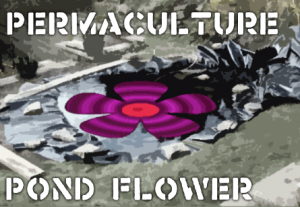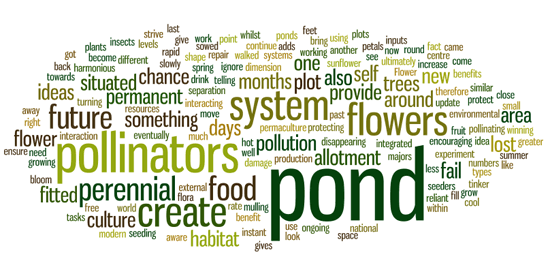During the last few months I have been slowly turning one of my allotment plots into a perennial permaculture food and resources system, I have now got the point where I have fitted a small pond, I am aware of all of the benefits that a pond can bring to a growing area, but something was telling me to tinker and experiment with some ideas to see if I could come up with something that was very integrated and that fitted well with the area where it was situated. After days of mulling over some ideas I walked up to my plot and it came to me in an instant – The pond is round like the centre of a sunflower, I sowed perennial and self seeding flowers around the pond in the shape of petals, which will give some space and separation to the flowers as they grow and eventually bloom and fill out.
How does a pond flower work?
 The idea here is that the pollinators will use the pond to drink from and cool themselves on hot days, whilst the flowers around the pond will provide them with food. The pond is situated a few feet away from my fruit trees, this gives the pollinators and the trees a greater chance of interacting. There will also be other plants close by the pond flower that will benefit from similar interaction with the pollinators. As I am using perennial flowers for this system and some self seeders it also adds a more ongoing and permanent dimension to this system where it will become less reliant on external inputs. During the spring and summer months I will provide another update of how this new system is working within my allotment plot.
The idea here is that the pollinators will use the pond to drink from and cool themselves on hot days, whilst the flowers around the pond will provide them with food. The pond is situated a few feet away from my fruit trees, this gives the pollinators and the trees a greater chance of interacting. There will also be other plants close by the pond flower that will benefit from similar interaction with the pollinators. As I am using perennial flowers for this system and some self seeders it also adds a more ongoing and permanent dimension to this system where it will become less reliant on external inputs. During the spring and summer months I will provide another update of how this new system is working within my allotment plot.
Flower ponds of the future
As we strive to create a pollution free and harmonious world, if we look after and create the right habitat for pollinators we can increase their numbers that have been lost to all different types of environmental pollution we are in with a chance of winning back some of the flora that we have lost, we therefore need to create these habitat systems on both national and local levels to ensure that we repair the damage of the past to create a permanent culture of the future, protecting and encouraging pollinators is one of our majors tasks as we move towards this new culture of the future. If we fail to protect our pollinating insects and continue to ignore the fact that they are disappearing at a rapid rate, then much of modern food production will ultimately fail.
Steve

